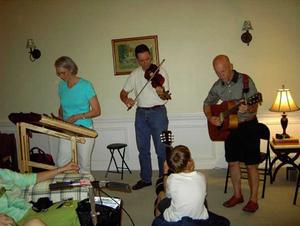

Learning to play the hammered dulcimer and dancing made such a difference in the life of Rebecca Lowry , left, that she began researching the use of experssive and creative arts in her professional career, couseling.
Rebecca Lowry is a professional counselor who earned a certificate in Expressive Arts Therapy at Appalachian State University (ASU) and uses the therapy in her practice. She lives in Winston-Salem, N.C. but attended King College in Bristol, Tenn. and is a native of Wythe County, Va.
In 2005, out of a need for self-care as a counselor, she says, "I intentionally returned to some creative and expressive outlets that I had neglected for decades. The two things that I chose were learning a new musical instrument (hammered dulcimer) and dancing (Contra and English Country). These activities made such a difference in my life that I began researching the use of expressive and creative arts in counseling; through that research, I discovered the graduate certificate program at ASU. The use of expressive arts in therapy is powerful. It engages the senses, allowing clients to experience themselves in a different way. It engages the imagination, which can then be used in problem solving."
Lowry continues, "Shaun McNiff, who is one of the leaders in the field of expressive art therapy, says that art and creativity are the soul's medicines -- what the soul uses to minister to itself, cure its maladies, and restore its vitality. He believes that the artistic process will always take us where we need to go and show us what we need to see. Creative and expressive therapies can be used to complement various counseling theories and are capable of holding all points of view. They are synergistic with practically any goal or approach. Because of the synergy, the effects cannot be planned in advance. There are always surprises. Making, doing, and creating energizes individuals, redirects attention and focus, alleviates emotional stress, and allows clients to more fully concentrate on issues, goals, and behaviors. Art can serve as a container to hold suffering, helping us to bear it courageously. Most importantly, I believe, the expressive arts provide the vehicle for clients to tell their stories -- through words, imagery, body movements, music, and various other modes."
She explains, "One of the differences between Expressive Arts Therapy (EAT) and Art Therapy is that the work is interpreted only by the creator. The therapist witnesses the art but allows the author/creator to give it meaning or to find meaning in it. Also there is an intermodal aspect to EAT. For example, one might write a poem about his painting, which he created while listening to music. With EAT, there is no judgment made on the piece of art. There is no right or wrong, which frees one to simply create and express. The process is as important, if not more important, than the product."
Lowry cites some examples from her work:
--- A 12-year-old girl whose mother had died recently and who was angry at the world, found a way to communicate her pain and her needs through her drawing.
--- A woman was able to express her grief over the murder of her 20-year-old son by writing remembrances of him, using the model of a sacred writing as a container (the book of Lamentations, which is an acrostic poem in the original Hebrew).
--- An adolescent client began to trust and connect with the therapist through making a collage together.
--- An overworked and stressed social worker found respite through drawing and collage-making while listening to soothing music.
--- A young woman chronicled her journey through breast cancer treatment using photography. No words were needed.
For more information about ASU's certificate program, visit their website:
http://www.ced.appstate.edu/departments/hpc/programs/expressive_arts/index.htm
READ ON: One area hospital sees healing power in the arts: Bristol Regional Medical Center.